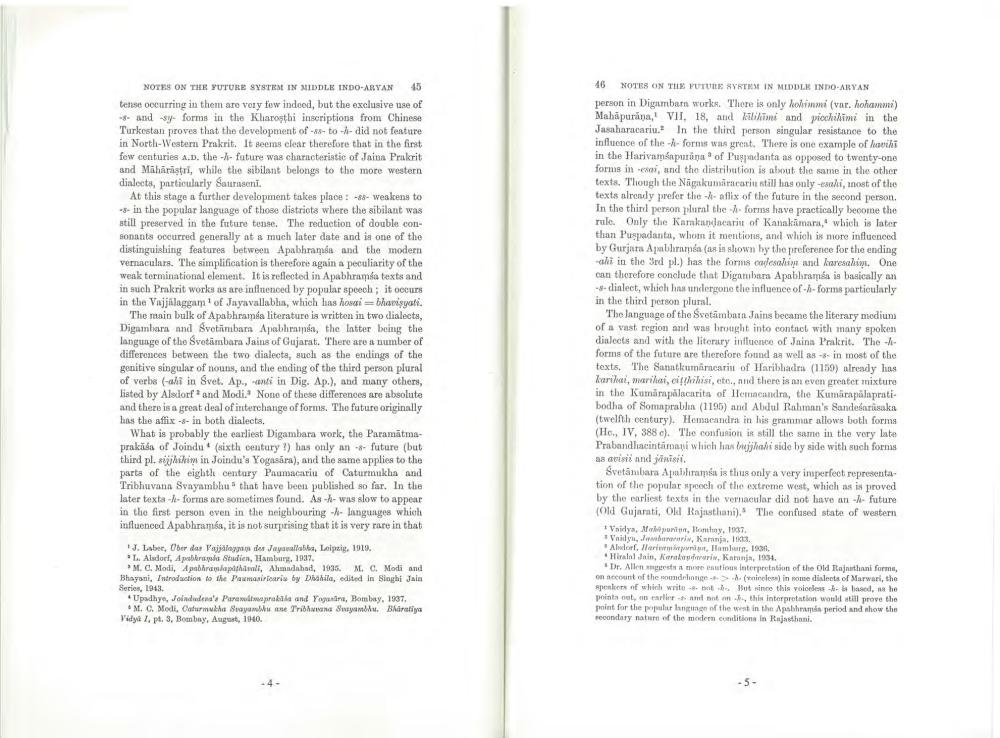________________
NOTES ON THE YUTURE SYSTEM IN MIDDLE INDO-ARYAN 45 terse occurring in them are very few indeed, but the exclusive use of
aud -sy- forms in the Klarosti inscriptions from Chinese Turkestan proves that the development of -88-to-- did not feature in North-Western Prakrit. It seems clear therefore that in the first few centuries A.D. the -|- future was characteristic of Jain Prakrit and Maharisti, while the sibilant belongs to the more western dialects, particularly Saurseni.
At this stage a further development takes place: -88- weakens to -3- in the popular language of those districts where the sibilant was still preserved in the future tense. The reduction of double consonants occurred generally at & much later date and is one of the distinguishing features between Apabhrama and the modern vernaculars. The simplification is therefore again a peculiarity of the weak terminational element. It is reflected in Apabhrama texts and in such Prakrit works as are influenced by popular speech; it curs in the Vajjalaggam of Jnyavallabha, which has hosgiebhansali.
The main bulk of Apabhram a literature is written in two dialects, Digambarn and Svetinbam Apabhrams, the latter being the language of the Svetambara Jains of Gujarat. There are a number of differences between the two dialecta, such as the endings of the genitive singular of nouns, and the ending of the third person plural of verbs -ahi in Svet. Ap., ants in Dig. Ap.), and many others, listed by Alsdorf and Modi. None of these differences are absolute and there is a great deal of interchange of forms. The future originally has the affix -- in both dialects.
What is probably the earliest Digamhara work, the Paramātmaprakiss of Joindu (sixth century ?) has only an -- future (but third pl. shikimin Joindu's Yogasára), and the same applies to the parts of the eighth century Paumacariu of Caturmukha and Tribhuvann Svayambhu that have been published so far. In the later texta -- forms are sometimes found. As -- was slow to appear in the first person even in the neighbouring -- languages which influenced Apabhrama, it is not surprising that it is very rare in that
46 NOTES ON THE FUTURE SYSTEM IN MIDDLK INDO-ARYAN person in Digambarn work. There is only hom (var, hohamm) Mahapurana, VII, 18, and kilikin and pickihime in the Jasaharacariu. In the third person singular resistance to the influence of the fornis was great. There is one example of lachi in the Harivamparina of Pandanta as opposed to twenty-one forms in ea, and the distribution is about the same in the other texts. Though the Nagakumirearstill has only-, inost of the texts already prefer the -- aflix of the future in the second person. In the third person plural the forms have practically become the rule. Only the Kamandacaru of Kanakamara, which is later than Puspadanta, whom it mentions, and which is more influenced by Gurjata Apaburmia (as is slown by the preference for the ending
ki in the 3rd pl.) has the forms cadeam and Kareshiw. One can therefore conclude that Diganiban Apabhrama is basically an --dinlect, which has undergone the influence of -- forma particularly in the third person plural.
The language of the Svetämbar Jains became the literary medium of a vast region and was brought into contact with many spoken dialects and with the literary influence of Jains Prakrit. The -- forms of the future are therefore found as well as in most of the texts. The Sanntkumirncari of Haribhadra (1159) already has Karin, mariai, visite, and there is an even greater mixture in the Kumarapalacarita of lemacandra, the Kumarapalaprati bodha of Somaprabhu (1195) and Abdul Rahman's Sandesausaka (twelth century). Hemacandra in his grammar allows both forma (Ho, IV, 388 c). The confusion is still the same in the very late Prabandhucintamani which has belah side by side with such forms as avisi and jinisit.
Svetambara A bhirama is thus only a very imperfect representa tion of the popular preech of the extreme west, which as is proved by the earliest texts in the vernacular did not have a future Old Gujarati, Okl Rajasthani). The confused state of western
Vaidya, Mbuntu, Handy, 1937. Vnity, wh in, Kaja K. Alorf, Harmonlamurt. 13. Hall Jain, Ka
r in, kann, 1934. Dr. Allen
Mo tion Internation of the Old Tajnathani formi, on scent of the sounding
wireless) in nome dialects of Marwari, the apeners of which writo -
But since this voicedes sed, he pointa t erl
a nt , this interpretation would still prove the point for the
age of the worst in the A lhami period and how the recondary name the modern conditions in Rajsthani
J. Laber, der das vajala do Jaywallas, Leipzig, 1919. L. Alsdorf, Apabbra Shidien, Hamburg, 1937.
M. C. Modi, Apabranapithimi, Ahmadabad, 1936. M. C. Modi and Bhayani Introduction to the Pawmasiraris by D ila, edited In Singhi Jain Series, 1943.
Upadhys, Jolandadena's Par mu r alla and Yogarine, Bombay, 1987,
M. C. Bolt, amikha Bw a ne Tribh Susu . Bharatiya Vidy I. pl. 3, Bombay, August, 100.




